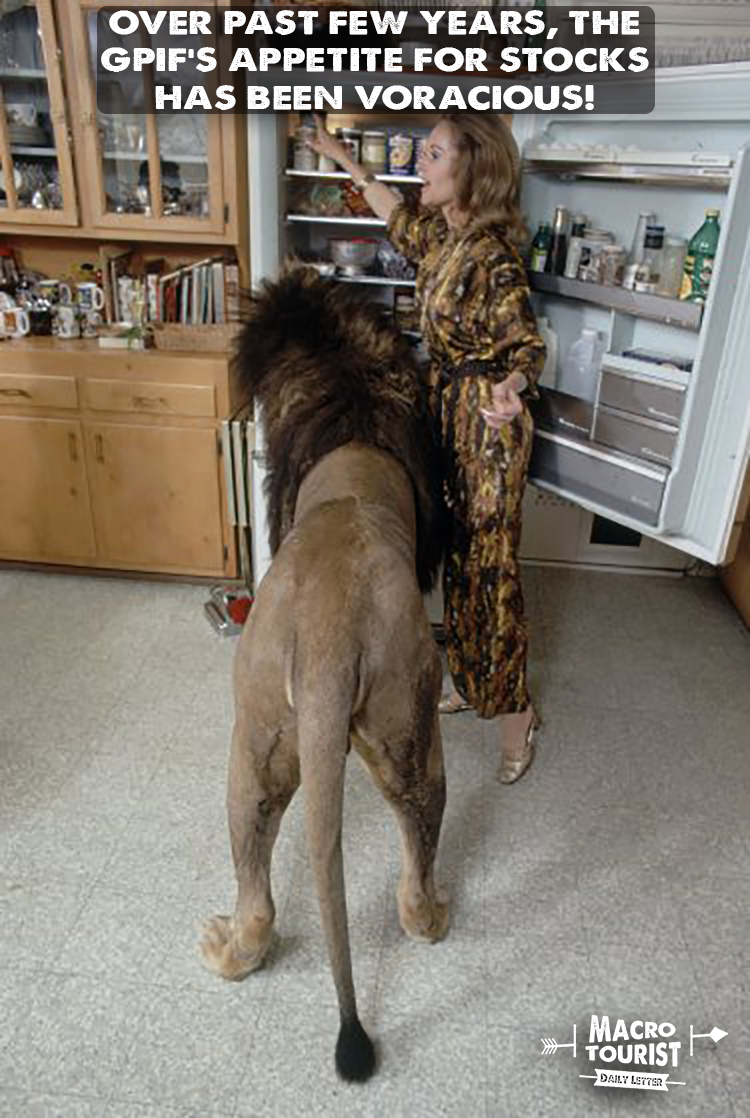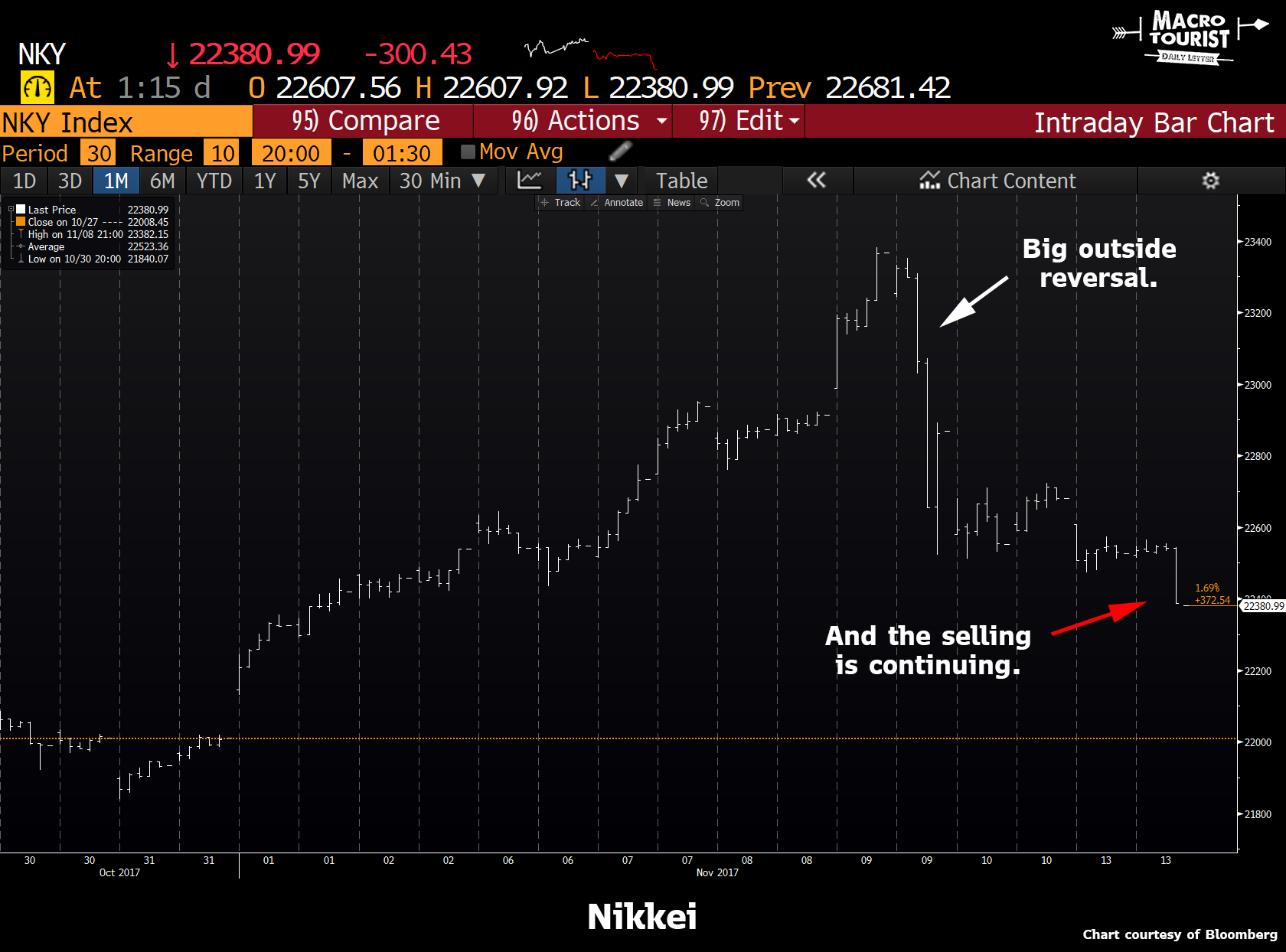
Authored by Kevin Muir via The Macro Tourist blog,
A few years ago, the Japanese government made an announcement that went unnoticed by many market pundits.
Since then, although there have been a few strategists who have speculated on its impact on risk assets, on the whole, it’s not something that gets a tremendous amount of attention. And that’s a mistake because it has had an immense effect on markets.
In October of 2014, the world’s largest pension plan, the enormous Japanese GPIF (Government Pension Investment Fund) reported a dramatic shift in their asset mix. From the FT:
A long-awaited overhaul of Japan’s national pension fund surpassed investors’ expectations on Friday, as the world’s largest institutional investor said it would put half of its assets in stocks while cutting its government bond holdings by a third.
The reshuffle of the Government Pension Investment Fund, apparently timed to maximise the impact of another shot of monetary stimulus from the Bank of Japan, was the result of almost two years of pressure from the administration of Shinzo Abe, prime minister.
Mr Abe has been keen to see the GPIF adopt a much more aggressive approach in managing its Y127tn ($1.14tn) in assets, in order both to meet the rising cost of pension payouts and to support his broad programme to haul Japan out of years of deflation. Since being cut free of direct state control in 2006, the GPIF has stashed most of its money in low-yielding government bonds, with almost all of the rest managed passively.
Under its new asset mix announced on Friday evening, the GPIF will cut its allocation to domestic bonds to 35 per cent from 60 per cent, while upping its share of domestic stocks from 12 per cent to 25 per cent. International bonds will climb from 11 per cent to 15 per cent, while international stocks will rise to 25 per cent, from 12 per cent. The old 5 per cent allocation to short-term debt has been scrapped.
The new allocations - which allow swings of about one-third in either direction to take account of market movements - were more aggressive than the market had anticipated.
Analysts said the 25 per cent allocation to domestic stocks, in particular - higher than earlier soundings of 20 per cent, which implied about Y7tn of inflows - could rekindle foreign investors’ interest in the Japanese market, which has waned this year after record net buying in 2013.
On Friday the Topix gained more than 4 per cent while the yen approached a seven-year low of 112 against the US dollar, after investors digested a story on the GPIF’s planned shift in the Nikkei newspaper and then the surprise expansion of the BoJ’s already-aggressive easing programme after lunch.
Analysts noted that the BoJ had committed to buying another Y30tn of government bonds each year - roughly equivalent to the Y34tn to be offloaded by the GPIF under its new asset mix, according to Goldman Sachs calculations.
Now, over the past couple of years, it’s not like GPIF has been the only buyer. But they are big. Niagara Falls big. Everest sized. To think their footsteps haven’t been felt in this mind boggling rally is naive.
So let’s think about what has happened. The GPIF has sold their JGB’s, at a rate that just happened to coincide with the BoJ’s increased QE program (Y34 trillion), and with that money, they have invested in domestic and foreign stocks.
In essence, the BoJ engaged in a massive quantitative easing program where they printed bonds to buy stocks. Yeah, they are doing it through their public pension plan, but make no mistake - it was no coincidence that the amount of increased QE was the exact amount of bonds the GPIF needed to sell.
Stamp a ticket, they are full
Well, guess what happened this week? And before I go any further, a huge tip of the hat to JonesTrading’s Dave Lutz who brought this to my attention (if you are an institutional buy-side client, give Dave a buzz on the Bloomie to be hooked up for his daily commentary - best in the biz).
According to the Nikkei Asian Review, the GPIF has now reached their 25% allocation to domestic stocks.
TOKYO – Steady buying by overseas investors has driven the recent rally in Japanese stocks, with domestic contrarians pulling in the other direction, though sharp market swings Thursday hint that a shift may be underway.
Overseas investors were net buyers of Japanese stocks and futures for eight straight weeks through Nov. 2, to the tune of 5.4 trillion yen ($47.5 billion), data released Thursday by Japan Exchange Group shows. Markets were closed Nov. 3 for a holiday.
The trend began the week ended Sept. 15, stemming mainly from hedge funds and other speculators covering short positions in futures. With tensions over North Korea easing at the time, “hedge funds said they’d lost their reason for selling Japanese stocks,” said Eiji Uejima of Daiwa Capital Markets Hong Kong.
After the short-covering ran its course in late September, overseas long-term investors came to the fore with trades based on corporate earnings, confirming companies’ first-half performance with the wave of earnings releases that began in late October. Semiconductor-related names and machine-tool makers in particular benefited from the trend.
Japanese stocks still look cheap from a global perspective, argues Andy Brown of British investment firm Baillie Gifford.
Japanese investors, meanwhile, have been selling almost uniformly, with the exceptions of corporate share buybacks and the Bank of Japan’s purchases of exchange-traded funds. Japan’s traditionally contrarian retail investors have been selling to take profits since the Nikkei average neared 20,000 in mid-September. Individual investors sold 2.4 trillion yen more in stocks and futures than they bought over the eight weeks through Nov. 2.
Trust banks – which reflect moves by pension funds – were also net sellers, though their total came to a more modest 480 billion yen. The enormous Government Pension Investment Fund, having largely reached its target weighting of 25% for Japanese equities, is now selling into strength and buying into weakness as well.
Let me repeat that last line again. “The enormous Government Pension Investment Fund, having largely reached its target weighting of 25% for Japanese equities, is now selling into strength and buying into weakness as well.”
Stop and think about that. One of the largest equity buyers in the world has just announced that they are full, and will be selling into rallies.
Any wonder that the chart of the Nikkei over the past week looks like this?

And if you think that the GPIF isn’t doing the same with their foreign stocks, then I have an ICO to sell you.
One of the biggest underlying bids to the recent stock market rally is now full. Be careful, it’s about to bite back.
